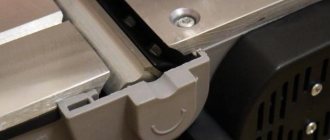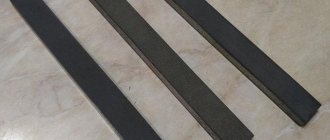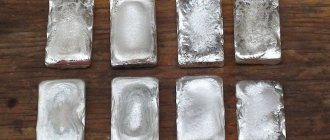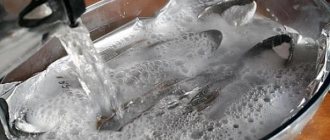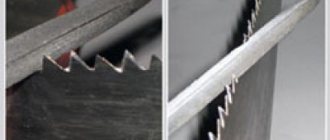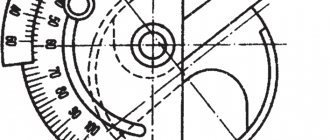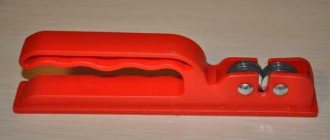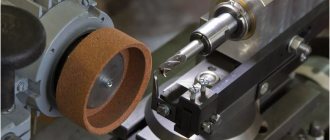Sharpening of knives can be carried out using a whetstone, sharpening machines, mechanical and electric sharpeners. There are devices that are used not for sharpening the edge of a blade, but for straightening them - for example, with the help of musat you can “in no time” restore the cutting ability of a knife.
If you need sharpening of professional knives, surgical instruments, or hunting “arsenal”, then you should turn to professionals or use special devices. The price of sharpening one knife in workshops can range from 100-350 rubles.
Types of whetstones for sharpening knives
Each type has individual abrasive properties, durability and features of use. Tools can have different shapes, the standard ones are “boat” and rectangular parallelepiped. Types of sharpening stones by material:
- Diamond. Often used for kitchen models. The advantages are ease of handling and durability. It should be noted that diamond bars have large abrasive particles that can leave scratches on the blade, which will affect its external qualities, but will not affect the cutting ability.
- Ceramic. They have medium to fine grains on the grinding surface. Such bars are more susceptible to clogging with metal particles, so it is recommended to use a soap solution instead of water during work.
- Made from natural stone. Particle sizes range from small to large. Before work, it is better to lubricate the bar with mineral oil (but not vegetable oil, since over time its residues will polymerize and spoil the sharpener matrix).
- Elborovye. Medium and fine grain. They are inferior in strength to diamonds.
- Japanese water stones. Fine grain. This type is also called a “touchstone”. Used to sharpen the blade after rough cutting. Before work, the bars are soaked in water for 15-20 minutes to clean the stone pores. Be prepared for more dirt to accumulate on the grindstone due to the wetting of metal dust.
The amount of metal removed by abrasive particles is directly proportional to their size. Coarse-grained stones are used for initial processing of the blade to remove flaws. Medium and fine-grained - for finishing and final polishing. Accordingly, the smaller the grain size, the sharper the edge will be.
Grinding whetstone made of natural stone.
The stone should be chosen the same length as the blade, but preferably 1.5-2 times longer. To begin with, you can take one medium stone or a double-sided block with different grain sizes.
When purchasing a sharpening stone, make sure that it is not chipped or cracked. Otherwise, you risk damaging the blade.
The bars marked “Made in the USSR” have high-quality material with uniform grains. You can find them at flea markets.
Tips for quickly sharpening a blade using improvised tools
Stone
You can quickly sharpen a knife on a hike or on a picnic using an ordinary cobblestone. Use any stone lying on the ground instead of a whetstone and run the knife blade along its surface. You won't achieve razor sharpness, but you will return the knife to working condition.
Second knife
It is quite possible to sharpen two knives at once, without sharpening stones or tools. To do this, you need to take a knife in both hands and begin to sharpen the blade of one knife on the blade of the other. After 5-10 minutes of this work, the knives will become sharper than before.
Glass objects
The knife blade can be slightly sharpened on the rough edge of glass or ceramic objects. For example, on the bottom of a glass or the edge of a tile. The main thing is that the surface is rough.
Leather belt
A leather belt is more suitable for finishing and giving the knife blade a razor sharpness than for rough sharpening. But if there is nothing at hand except a belt, then you can try to sharpen the knife on it. To do this, you need to tighten the belt and start moving the blade along it; you may not achieve strong sharpness, but you will polish the knife to a shine.
By learning to sharpen knives and tools yourself, you will acquire a skill that will be useful to you throughout your life!
How to properly sharpen knives with a whetstone: step-by-step instructions with photos
Installing and fixing the sharpening stone
Safe and efficient turning is possible when the sharpener is stationary. It can be placed on a rubber mat, in a special frame, or secured with nails or a clamp.
Fixing the knife block with nails.
In addition, there are devices that allow you to secure stones and blades in the system (sharpening angles). In such devices, the angle of inclination is adjusted and immobility is ensured.
Determining the sharpening angle
To determine the angle, you can use a square piece of paper folded several times. So, a square folded in half once displays an angle of 45°, and if folded a second time, we get 22.5°. This stencil is suitable for kitchen models.
A piece of paper to determine the sharpening angle.
Proper sharpening process
For the first time, practice on a knife that you don't mind. This way you can get the hang of it, get a feel for the key points and then move on to the main instrument.
- Position the knife perpendicular to the stone so that the beginning of the cutting edge at the handle coincides with its edge.
- Select the required angle by tilting the blade not with the movement, but against it. Paper and cardboard blanks will help with this.
- Now move the knife away from you, pressing lightly with your second hand. Make sure that the entire blade is sharpened to the end of the stone. Gradually raise the handle as the contact point moves along the edge to maintain the angle. Try to drive smoothly, otherwise sharp jerks may leave chips and deep nicks on the tip.
- Turn the knife over and do the same on the other side, taking the handle in your other hand. For uniform sharpening, make only one movement per side.
During the initial processing, you can determine whether the edge is even by placing the blade at an angle to the light. This way chips and unevenness will be visible. They look like lines and dots.
Metal dust will be generated during sharpening. It needs to be washed off so that it does not affect the quality of turning. If you use containers of water for cleansing, then there should be one for each stone. Otherwise, the pores of the sharpener will become clogged with metal particles of the wrong size.
After use, wash the knife with soap and rinse the bar so that abrasive particles and metal shavings do not get into the food. Over time, when working with the same stone, it becomes clogged and becomes ineffective. This can be corrected by sanding off a small layer with sandpaper.
If you decide to sharpen the blade in several stages, using stones of different grain sizes, then you need to do this in order of decreasing grains.
Fighting burrs on the blade
Burrs form on the cutting edge between the planes when the required amount of metal has already been removed and further sharpening will not lead to improvement. The fight against them is carried out on a fine-grained stone or sandpaper. Instead, you can use an abrasive paste. It is sold in hardware stores. To do this, apply and rub the paste on smooth leather (for example, a belt), then perform the same actions as during the main processing, but with the knife tilted in the direction of movement.
How to choose a sharpening machine?
For household work, it is best to use electric models for household use. Today these are universal units with a desktop installation method that cope with the restoration of blades not only of knives, but also of axes, chisels, all kinds of cutters and scissors.
It is advisable to give preference to knife sharpening machines with an adjustable angle, which will initially improve the quality of the operation. Moreover, it is important to pay attention to the configuration of the working equipment. Firstly, much more sharpening capabilities will be provided by a machine that allows the use of an abrasive disc and tape. Secondly, it is more convenient to use a setup with two circles on different sides. The fact is that the process of point correction may require the use of abrasives with different degrees of grain size. To avoid wasting time on reinstalling them when moving from one circle to another, it makes sense to take care in advance about the possibility of installing two elements simultaneously from different sides.
Checking the quality of sharpening
A sharp knife when sharpened correctly.
There are several ways to check the sharpness level of a knife. They do not require special skills or materials.
On paper
Take a piece of office paper and cut off a corner without any effort. If the knife is not sharpened, it will tear the sheet.
On a tomato
Soft vegetables and fruits are crushed under the influence of a blunt blade. Sharp ones can cut the thinnest slices. Knives, brought to the level of a straight razor, have enough of their own weight to cut a tomato.
Testing on hand hair
A well-sharpened blade will shave hair without any problems. This method should be used with caution, as if the angle is incorrect, there is a risk of cutting yourself and causing infection.
On a hair
For this test, you need to take a long hair and lower it onto the blade turned upside down. If the hair is cut in two under its own weight, then this is an indicator of razor sharpness.
With sufficient sharpness, you can plan the hair by moving it at an angle to the knife.
What should you know about sharpening stones?
Comprehensive maintenance of knives, even if you have a machine with abrasive wheels, is unlikely to do without a touchstone. This granular block will allow, if necessary, to correct the result obtained on the machine, as well as support the operation of the tool in the field, if necessary.
In addition, some electric units are fully equipped with such bars as consumables. How to sharpen knives correctly on this type of sharpening machine? The principle is somewhat similar to mechanical and electrical machines on circles. The only difference is that the operator does not need to make any special efforts. The main work will be done by the device itself. The maximum that will need to be done is to ensure external control of the process.
Of course, a lot will depend on the sharpening stone itself. They are ceramic, abrasive and natural. If we are not talking about using the product as part of an electric machine, then before work it is better to moisten it with a soap solution. This technique will improve glide and prevent intense spraying of small particles from metal and abrasive.
Preventing the knife from becoming dull
A blunt instrument can come off at any time and injure the owner. This is not only inconvenient, but also unpleasant to cook with. Therefore, it is important to sharpen regularly. How often it will have to be done depends on the strength of the material from which the knife is made, and on how carefully it is wielded. Below are tips to help increase the time between forced sharpenings:
- Do not cut on surfaces harder than wood, such as glass, metal, ceramic, porcelain, etc.
- Do not use the cutting edge to crush hard foods (bones and ice, for example). For these purposes it is better to take a special tool.
- Use the knife for its intended purpose - to cut. They should not pick nails or open cans or bottles.
- Rust affects the need for sharpening. Once in the human body, it has a toxic effect. After washing the dishes, you need to thoroughly dry the iron utensils or at least leave them in a well-ventilated place.
If you still have questions about sharpening knives with a whetstone, the video will clear them up. It shows the sequence of the described actions, and it will be easier for you to repeat them.
Previous
National knivesTypes and characteristics of national Uzbek knives pchak
Next
Sharpening knivesHow and with what to sharpen ceramic knives
How to check the grinding wheel?
Whatever wheel is used in the work, it must be carefully checked before performing the operation. The audit must begin with a visual inspection. The item should not have the slightest crack or even chip.
Next, a check is performed on the machine. For this procedure, it is better to use a professional knife sharpening machine, which provides more effective safety features and customization options. On it, in particular, it will be possible to check the abrasive wheel for runout. This defect is expressed in vibrations, when, upon external observation, the outer edge of the disk moves away from the center to the sides. If such a flaw occurs, then the abrasive will need to be corrected with a special diamond device.
Sharpening and editing
First, let's separate these two concepts. Sharpening is the formation of a cutting edge (CR), and editing is needed to bring this edge to working condition. At high magnification, the cutting edge of a knife sharpened on a large block looks, frankly, unimportant and resembles a rock ridge eaten away by erosion.
Editing the paint using a fine abrasive allows you to bring this visual nightmare to a more or less decent state. The knife begins not only to cut, but also to shave (if, of course, you did everything correctly).
Leave the knives alone!
For some this will be a revelation, but there are knives whose blades cannot be sharpened , otherwise they will be damaged forever! These include:
- Knives with a serrated blade , or serrated knives. Outwardly they resemble a saw. But they differ from carpentry tools in that the shape of their sharpening is asymmetrical relative to the blade. Serrators can be located along the entire length or on some segment (half-serrators). You can sharpen them, but this requires special equipment and skills that the home master does not possess. Conventional double-sided regrinding destroys them.
- Knives with branded coating . For example, the company Zwilling JA Henckels produces TwinStar Plus knives. A unique composition is applied to their cutting part, thanks to which wear resistance increases many times over. And during the turning process, the protective coating is erased.
Briefly about Japanese knives
Japanese knives with their variety of shapes and functions are a separate big topic. What unites them is their unsurpassed quality and the traditional Japanese weapon steel of the blade - tamahagane.
Like any quality tool, Japanese knives require care and proper handling. In addition, such a kitchen tool costs an order of magnitude higher.
Edit or sharpen?
Before you get started, it's worth finding out what kind of maintenance your cutting edge needs.
At home, you have two ways to make a knife sharp:
- If the knife is slightly dull, edit it .
- If the blade has not been serviced for a long time or is damaged, sharpen it - remove excess metal from the sides of the cutting edge.
A worn knife with severe damage to the blade - chips, chips, bends - needs professional repair. But it is quite difficult to do it at home, and you will probably have to contact a workshop.
Types of sharpening machines
The most important characteristics of sharpening machines are:
- blade material (coarse and fine-grained abrasives, diamond-coated blade, ceramics, carbide);
- the presence or absence of an angle adjustment option;
- equipped with a blade lock.
For proper sharpening, the simple Soviet method is also suitable, in which the cutting edge is leveled and polished using a whetstone. This will require knowledge of technology, otherwise there is a chance of grinding off excess or repeating the procedure too often.
There are also more expensive attachments for knives. Some sharpening machines are equipped with electric motors.
Electric sharpeners
Electric sharpeners are a modern alternative to whetstones and whetstones. These devices can be adjusted to suit different types of blades. The knife is guaranteed not to be damaged. Sharpening one product, often together with grinding, takes up to 2-3 minutes.
Electric sharpeners differ in power levels and additional equipment. The most expensive and professional cutters are equipped with three grooves with different disks. They provide a three-step process and not only sharpen the cutting edge, but also polish it.
An expensive tool is necessary when you need to sharpen ceramic and exclusive products made from elite materials. Ceramic kitchen knives have become popular, but they are difficult to sharpen without preparation. There is a risk of crumbling and deforming the cutting part.
Mechanical type sharpeners
While complex electrical devices are more suitable for professional use, mechanical sharpeners are suitable for household use. Among them:
- v-shaped sharpeners (quickly lead to wear on the knife);
- roller blades.
This type of sharpening device is more complex than a regular whetstone. However, it does not require a power source.
A mechanical knife is based on two elements: a handle for the stop and a pair or several pairs of disks for the blades. The angle between the abrasive discs is already preset; you just need to select a groove and fix the edge.
Mechanical sharpeners of varying degrees of complexity may also include devices for polishing, clamps, and additional abrasive discs.
Why do knives become dull?
This is a fairly serious and common problem even if the steel has the required hardness parameters. Why then does its razor sharpness lose so quickly after sharpening?
The reasons are completely different. It is worth noting the first and main one, that regardless of the hardness of the blade material, when using it, it is one way or another subject to third-party influence. The frictional force acts on the blade in such a way that it leads to the separation of microscopic particles from the base, which causes its gradual destruction. In particular, it is impossible to constantly maintain the “ideal position” (contact of the cutting edge with the plane at optimal angles) when using a knife. The occurrence of loads has a destructive effect on the metal product, which entails a loss of razor sharpness.
But due to the microscopic nature of the process, it is quite difficult to check the sharpness of the product. The first signal of its dullness is the increasing effort that a person makes in the process of cutting an object using such a knife. You can find out whether the device has lost its sharpness even by eye: the dull part of the blade has a polished appearance and signs of a characteristic shine. In the presence of such defects, we can talk about the need that it is time to sharpen the blade like a razor. To make the process as efficient as possible, care must be taken to select the right tools.


